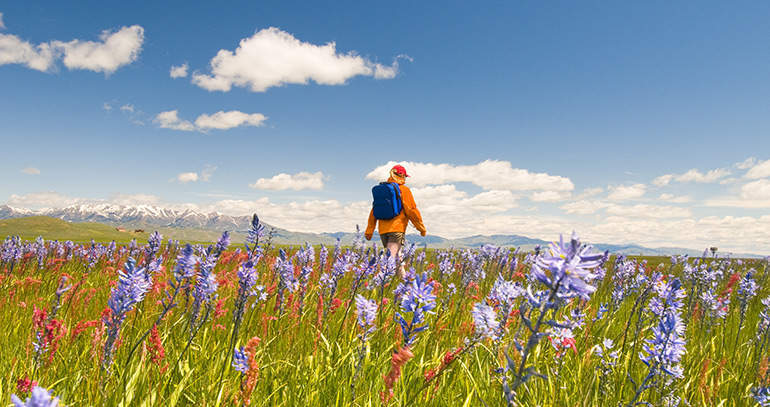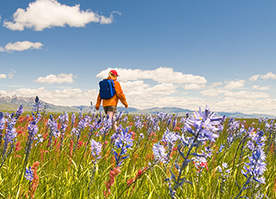
Every year, the cold winter gives way to an abundance of colorful wildflowers throughout Southern Idaho. Wildflower enthusiasts can find everything from incredibly rare, high-altitude flowers to carpets of colorful camas blooms. The biggest profusion of flowers is in late May and early June, so start planning your trip now!
City of Rocks National Reserve
The wildflowers are already starting to pop up in City of Rocks National Reserve, which is home to about 500 species of these hardy little plants. You can expect to see sagebrush buttercup, Plains wallflower, Utah serviceberry, longleaf phlox — even several species of cacti. While you’re admiring the flowers, take a moment to notice the largest pinyon pine forest in Idaho, which once provided food for foraging Shoshone-Bannock peoples. Want to get really serious about your wildflower search? Print this checklist of 100 common wildflowers and bring it with you.
Best time for blooms: Now through October. Peak season for blooms is May through July.
Camas Prairie
Did you know that the Camas Prairie takes its name from the camas lily? These native blue wildflowers cover the valley’s floor every year — and, for thousands of years, these same plants sustained Native Americans living in the area. The Shoshone-Bannock and Paiute peoples used camas as a food source, roasting the bulbs and drying and saving them for later use.
The best time to see the camas lily bloom is in late May and early June, when the valley floor transforms into a blanket of blue. One of the most beautiful places to see the bloom is at the Camas Prairie Centennial Marsh Wildlife Management Area, a swampy place adorned with colorful wildflower blooms and thousands of birds and their tiny offspring. Keep an eye out for ruddy ducks, northern pintails, American wigeons, mallards, gadwalls, lesser scaup, canvasbacks, and blue-winged, green-winged, and cinnamon teals. Access roads allow you to get up close to the birds, and the scenic backdrop is a favorite of birders and photographers alike.
To truly celebrate the camas bloom, head to Camas Lily Day on June 2 in Fairfield. Festivities include a fishing derby for kids, live music, food and drink, and a community yard sale. Most events are free and open to the public.
Best time for blooms: Late May to early June
Camas Lily Days and Sho-Ban Homecoming: June 2, 2018, City Park, Fairfield
Craters of the Moon National Monument and Preserve
Craters of the Moon is surprisingly full of amazing wildflowers. Every year, dwarf monkeyflower, dwarf buckwheat, and silver-leaved phacelia cover the cinder cones, but more than 700 different types of plants put on a show throughout monument. Although June brings the most impressive show of flowering plants, the monument’s wildflowers will continue to bloom throughout the summer.
To learn more about these tenacious wildflowers, join retired Park Ranger Doug Owen on a two-mile walk through the park as he describes each plant and its habitat. Reservations are required and groups are limited, so book now! You’ll need sturdy walking shoes, a packed lunch, and water.
Best time for blooms: June
Wildflower Walks: 10 a.m.-1 p.m. June 2 and 9, 2018. Meet at the Tree Molds lot. Donations will be accepted to support school field trips. Call 208-527-1335 to reserve your spot.
South Hills
The hollows and ravines in the South Hills, just south of Twin Falls, Burley, Kimberly, and Hansen, are a great place to see the lush greenery that spring brings to the desert. There are plenty of trails for ATV enthusiasts, hikers, and bikers, and you can expect to see flowers like milk vetch, violets, and arrowleaf balsam root. For a fun hike, check out Wahlstrom Hollow: From south Twin Falls, bear left on Kimberly Road and drive five miles. Merge onto Highway 30 and proceed to Rock Creek Road, then drive 23 miles to the Third Fork Trailhead on the east side of the road. The trail is a nine-mile loop.
Best time for blooms: Mid-June.
Mount Harrison
Mount Harrison, located in the Albion Mountains northeast of Oakley, might seem like an unlikely place to find two of the rarest plants in the world. But this high peak is the only place on the globe where you can find Christ’s Indian Paintbrush, and one of only three places where you can find Davis’ springparsley.
Christ’s Indian Paintbrush grows in the highest elevations of Mount Harrison at about 9,100 feet. This rare plant is listed as critically imperiled because roads have infringed upon its natural habitat. Be sure not to drive off-road and to tread carefully so you don’t damage the plants.
Davis’ springparsley, part of the carrot family, also makes its home on Mount Harrison. This plant can only be found in Idaho and is listed as vulnerable, so please be careful around it.
Best time for blooms: June and July

